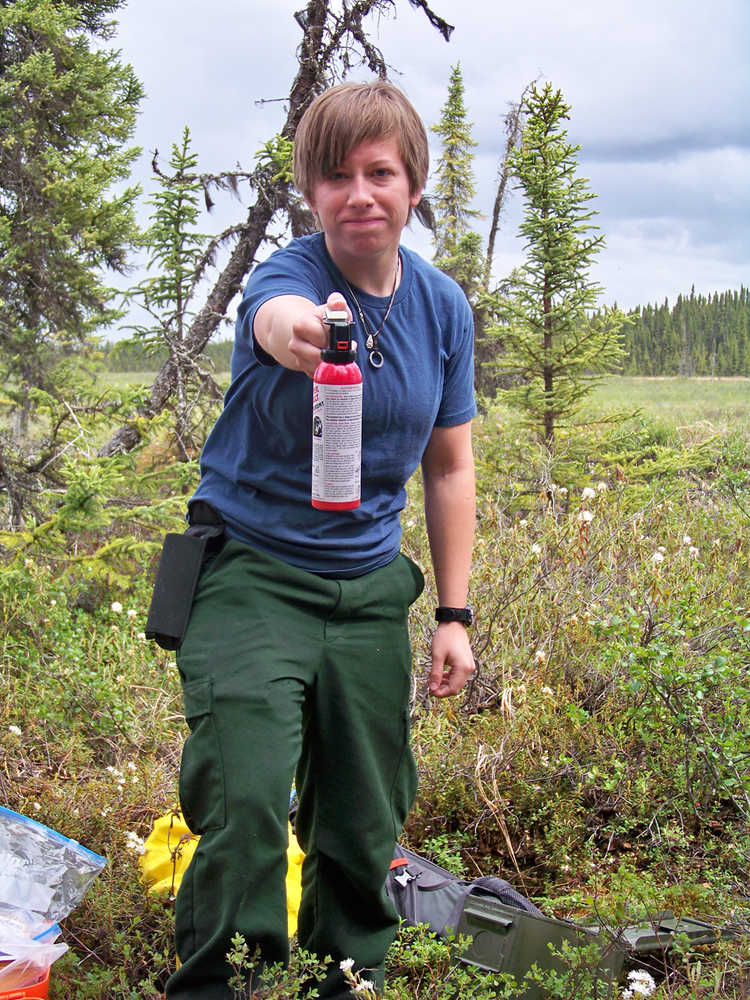Bear spray is a weapon. Just like any weapon, you’ve got to know how to use it so it stops what you want it to stop (a bear) and doesn’t stop you. What got me thinking about this story is just last week a friend and her niece ended up in our local ER when the bear spray canister stuck between her car seats accidentally deployed. Needless to say, lots of tears and crying.
In contrast to that event, several years ago a seasonal biotech at the Kenai National Wildlife Refuge was walking her aging dog along Schooner Bend on the Kenai River. Sue spotted a brown bear sow with cubs making a fast beeline for her dog. She yelled at the sow, only to have it turn and make a beeline for her. Sue backed up against a tree and crouched down as she deployed a canister at the charging bear. As the bear skidded to a stop in front of her, Sue could have reached out and swatted its muzzle! A happy ending (although there were probably tears and crying) as the bear turned and ran away.
Bear spray really does work. A 2008 article in the Journal of Wildlife Management reviewed 83 bear spray incidents in Alaska during 1985-2006. Threatening behaviors by brown, black and polar bears were stopped more than 90 percent of the time by spray, although in 18 percent of cases, bears had to be sprayed more than once. Only 3 bear-inflicted injuries associated with defensive spraying occurred — all involved brown bears and all were relatively minor, requiring no hospitalization.
But like any weapon or tool, it works better when you know what you’re doing. A few years ago, I took a course offered by Counter Assault, one of several manufacturers of bear deterrent spray. Here are the take-away messages:
Commercial bear spray typically contains 2 percent capsaicinoids (pepper) as the active ingredient, 1.5 to 2 times “hotter” than law enforcement spray. Unlike sprays used on dogs and humans, which usually come out as a stream to target the eyes, bear spray is inhaled, causing immediate inflammation of the lungs and respiratory distress. It is dispersed as atomized spray, usually orange or reddish brown in color so you can see where it’s going. It not only does NOT work as a deterrent if sprayed on a tent, the smell may actually be an attractant!
Most small cans contain about 8 ounces of deterrent and propellant, designed to spray out to 30 feet for 5 to 8 seconds. But here’s the catch. This specification is at ROOM temperature and the propellant pressure is sensitive to temperature changes. Despite rapid climate warming, how often is it 70 degrees on the Kenai Peninsula? So even though you should keep your spray handy and holstered outside your pack, you should also consider keeping it inside your coat when temperatures drop below 50, which it often does on summer mornings or fall days.
Conversely, really warm temperatures can cause a canister to leak and even explode. I saw one photo where a bear canister left on the dashboard of a closed vehicle had exploded and blown a hole through the windshield. If you regularly leave bear spray in your vehicle, consider keeping it in an ammo box. Kenai Refuge pilots transport canisters in the floats of planes rather than in the cabin to prevent catastrophic deployment. It only seems logical to take similar precautions in your car or truck.
The expiration date on your canister is a guide to go by, not carved in stone. Keep in mind that the effectiveness of the pepper doesn’t diminish, but the propellant pressure does. So store your canister in a cool place to minimize expansion and leakage. Dented or otherwise damaged cans should be used as backup spray or for training.
If you have reason to believe a bear is in the area, get your canister out and remove the safety clip. Stick your thumb under the trigger to prevent accidental deployment. Be aware of the wind direction!
Odds are that if you deploy bear spray, it will be on a charging bear. The key is to shoot in front of the bear because you want the fast moving animal to pass through the colored cloud. Spray downward using short bursts of 1 to 2 seconds. The typical deployment, according to the aforementioned journal article, is 12 feet from the bear!
In 14 percent of bear spray incidents, the sprayer was negatively affected by the spray. Medical treatment calls for removing contact lenses, flushing exposed areas with cool water and non-oil based soap, drinking milk, calming the person, facing into the wind, NOT applying lotion or creams, and using wet towels or ice packs to reduce inflammation. The good news is that the effects last only 30 to 45 minutes.
I have extra holsters that I’ve duct-taped to shoulder straps of various packs I own so a single bear canister can be easily transferred around. Bear spray in a pack doesn’t work. Even if I’m carrying a firearm, I or my partner will carry bear spray as a nonlethal alternative. It’s a great deterrent for older kids to carry, but keep it away from young kids. Bear spray deploys at about 70 mph and, at less than 5 feet, it can physically damage eyes. Remember, it’s a weapon.
John Morton is the supervisory biologist at Kenai National Wildlife Refuge. Find more information at http://www.fws.gov/refuge/kenai/ or http://www.facebook.com/kenainationalwildliferefuge.

